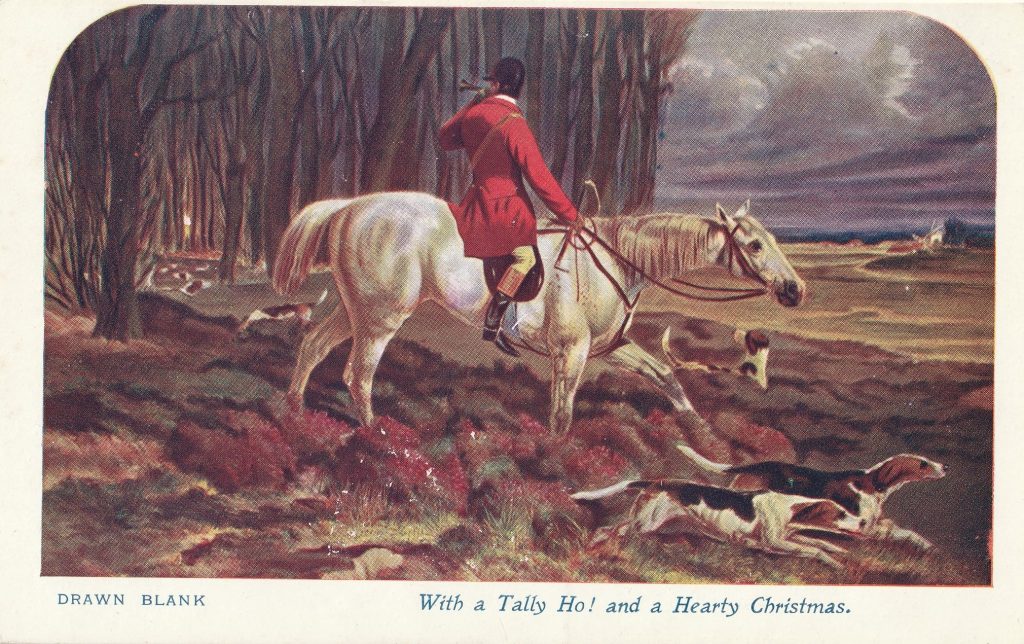
It is difficult to suggest that the festival of Christmas is in any way controversial, although a great many people shudder at the increased commercialism and the reduction of religious celebrations associated with Christmas.
This card is unused and undated, but since it supports an inland postal rate of 1/2d, it could date from before 1918. The title of the card is Drawn Blank with an additional seasonal message of “With a Tally Ho! and a Hearty Christmas” it is card No. 7 from The Owls series, but it has no named publisher.
The red-coated rider on a white horse in the illustration is blowing a hunting horn. He is surrounded by a pack of hounds. He may be reluctant in leaving the forest empty-handed. While there is no fox in the image the coat the gentleman is wearing, the hunting horn, the hounds, and the expression ‘Tally Ho!’ suggest the scene is a traditional fox hunt.
The word ‘traditional’ is used for the hunting of foxes with hounds in the style depicted, changed in recent years when the Hunting Act of 2004 (an act of the Parliament of the United Kingdom) imposed bans on the hunting of most wild mammals (notably foxes, deer, hares, and mink) with dogs in England and Wales.
Most citizens neither condone nor support the sport of fox hunting although they recognize that opinions differ greatly between town dwellers and country folk who may consider such hunts a form of pest control. There is no need to debate the practice, the card is included simply because it represents a form of Christmas celebration.
The image provokes many questions but three that should appear at the top of the list are: what are the current rules regarding fox hunting in the UK, what is the origin of the expression Tally Ho!, and why would a Christmas card display a hunting scene?
Near total defeat came quickly when researching the current rules on fox hunting. One would think that ‘blanket bans’ would be in force since the 2004 enactment, but it appears that this is not the case and there are numerous exceptions and regional variations to the rules. There is neither the time nor the patience to investigate further.
The term Tally Ho! was an easier point to explore. It is a traditional cry made by huntsmen to tell others the quarry has been sighted. The use dates from around 1772, and is probably derived from the French taïaut, a cry used to excite hounds when hunting deer. Taïaut may have originated in the second half of the 13th century by the concatenation of a two-word war-cry: taille haut. “Taille” is the cutting edge of a sword and “haut” means high or raised up. So, the original meaning might be something close to “Swords up!” Tally Ho is not, as one might imagine, used exclusively in hunting as it was adapted in the 19th century to describe forms of fast passenger coaches. It was further adapted in the 20th century by World War II R.A.F. pilots as a message to their controllers that the enemy had been sighted and was about to be engaged. The term is apparently used today by NASA when other spacecraft, space stations, and unidentified objects have been sighted.
Fox hunting is a relatively popular image on Christmas cards and fox hunting has long been a Boxing Day tradition. Boxing Day isn’t a traditional day of celebration in the United States although in many countries December 26th is a day inextricably linked to the Victorian era. The term was first included in the Oxford English Dictionary in the 1830s and became a bank holiday in 1871. During the Victorian era, churches often displayed a box into which the parishioners could put donations. British servants to the wealthy in the 19th century were given time off to visit their families as their services had been required for the Christmas Day celebrations of their employers. They were therefore allowed the following day for their own observance of the holiday; each servant would be handed a box to take home, containing gifts, bonuses, and sometimes leftover food.
Others say the origins of Boxing Day lie within another British tradition; the celebration of Saint Stephen’s Day – also December 26, annually. Metal boxes are said to have been placed outside churches in the Middle Ages to collect money during the Feast of Saint Stephen, who is known for distributing aid to the poor and helping widows.
The two theories certainly have an inherent connection, the use of boxes for gifts and help for those in need. Over the centuries it has been customary for tradespeople to collect Christmas Boxes of presents or money on the first weekday after Christmas as thanks for good service throughout the year.
Boxing Day was a day where families continued their Christmas celebrations by venturing out of their homes to enjoy entertainments including pantomimes, plays, variety shows, exhibitions, and sporting events such as football matches and hunts.
Happy Boxing Day, Bob, and thanks for the article. I don’t believe I’ve seen a Boxing Day postcard as of yet, but hopefully one day…
Thank you. Best wishes for the festive season.
A great article from across the pond.
Thank you for the article. I did not realize how often the fox hunt is pictured with winter holidays.
Thanks for your contributions to this magazine, Bob, and Happy New Year! As I type, it’s already 2024 in Scotland, but here in the eastern USA we have about two and a half hours left before the ball drops in Times Square and the strains of Auld Lang Syne ring out.